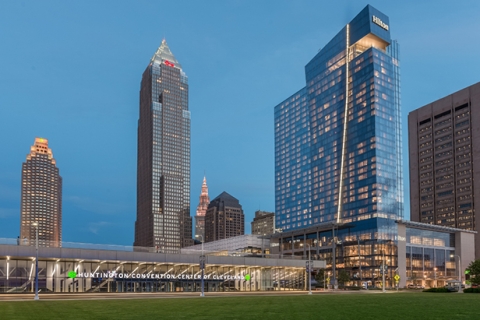Huntington Convention Center of Cleveland Diverts Massive Amounts of Waste in 2017

Last year was an especially green one for the Huntington Convention Center of Cleveland and the Global Center for Health Innovation, which knocked it out of the ballpark in the areas of waste diversion and recycling.
The facility, which is managed by SMG,succeeded in diverting a grand total of 357,274 pounds of materials from the landfill last year, including 75,880 lbs. of cardboard; 46,440 lbs. of wood pallets; 18,480 lbs. of mixed plastic; 14,780 lbs. of mixed fibers; 10,000 pounds of glass and nearly 9,000 pounds of bulk and shredded paper, sustainable efforts that diverted 49.1 percent of waste materials from the landfill as part of the building’s overall Reduce, Reuse and Recycle program.
As a member of the Cleveland 2030 District, a movement to create high-performance building districts throughout Greater Cleveland designed to dramatically reduce the environmental impacts of building construction and operations, the HCCC reduced greenhouse gas emissions by 1.26 percent in 2017, the equivalent of taking 19 vehicles off the road for a year, and reduced its usage of electricity, water and district steam heat.
“We are continuing to grow our efforts to increase the percentage of trash being diverted from the landfill and recycled by further sorting and employee training,” said Anastasia Volsko, HCCC director of operations.
She continued, “In December, we held employee training to educate our frontline employees on how to properly sort and recycle the most common items we encounter on a regular basis. We are also working with the Cuyahoga County Solid Waste District to improve our training programs and reduce our impact on the environment.”
Water refill stations are located throughout the convention center and based on usage, track the amount of water used in refillable containers, amounting to the diversion of the equivalent of 23,005 plastic water bottles from the landfill.
The property also boasts its “Real FarmVille” working farm that helps produce food in-house for catering purposes. Operated by the Levy and SMG team, the farm is home to 16 colonies of honey bees generating more than 2,000 pounds of honey annually; egg-laying hens that provide fresh eggs daily accounting for up to a quarter of the facility’s monthly shelled egg use; a variety of raised beds that feature seasonal greens, herbs and vegetables, and three Mangalista heritage breed pigs.
During 2017, Levy recycled nearly 25,000 lbs. of food trimmings and waste, including 13,500 lbs. of leftovers to the Keating Center through the Cleveland Food Bank; repurposing over 9,000 lbs. as food for the chickens and pigs, and recycling 1,650 lbs. of cooking oil.
The use of one-at-a-time napkin dispensers has reduced the HCCC’s napkin waste by 56 percent and the facility utilizes eco-friendly, biodegradable and compostable plates, box lunches, cups and flatware products.
In addition, Levy partners with Chef’s Garden in Huron, a local, family-owned 300-acre vegetable farm, to purchase produce from a source committed to sustainable agriculture using practices that replenish nutrients depleted from the soil and growing crops through natural means.
Levy also purchases food products that are sustainably raised and responsibly sourced wherever possible, including antibiotic-free poultry from Gerber Farms in Kidron; cage-free eggs; A2 all-natural dairy products from Fresh Fork Market as well as certified humane, hormone-antibiotic-free pork from Ohio City Provisions Pork-Chop Shop at the city’s West Side Market.
As if that wasn’t enough, the HCCC uses Grind2Energy to enable food waste to be converted into energy. Created by Emerson, this food waste recycling system grinds food waste onsite using an industrial-strength InSinkErator grinder, which is then converted into a slurry.
The quasar energy group, a Cleveland-based, full waste-to-energy company, then transports this material to a local anaerobic digestion facility to extract methane for energy production and to produce a nutrient-rich soil amendment.
Last year, the facility’s Grind2Energy system created 37.8 tons of slurry to convert to power, creating enough natural gas to heat 18 homes for one month; electricity to power 12 homes for one month; 4,583 lbs. of nutrient-rich fertilizer, and eliminated greenhouse gas emissions equivalent to 52,675 automobile miles.
As part of the HCCC’s Sustainability Donation Program, a new initiative that provides clients, exhibitors and contractors a simple solution to reduce the amount of waste generated from an event, the facility donated 26,980 lbs. of recycled materials to local organizations.
Products donated through this program included leftover carpeting, insulation, gardening equipment, fertilizer, pre-prepared food, building materials, stain, waterproofing, drywall, tools, children’s furniture, paint, landscaping brick, drywall and trim and were shared with local organizations such as Habitat for Humanity Restore, Edward Keating Center and Karamu House.
The facility also provides a biannual donation from the building’s lost and found to the Salvation Army, including clothing, coats, gloves, umbrellas and cold-weather gear.
“The convention industry has continued to evolve and improve centered around truly enhancing and meeting the changing demands of the customer experience for exhibitors and attendees,” said Ron King, general manager, Huntington Convention Center of Cleveland and Global Center for Health Innovation.
He continued, “This evolution goes far beyond simply delivering best-in-class customer service and includes all aspects of the facility, including developing a day-to-day building culture among all employees that embraces sustainable building practices, a first-class dining experience based on and supporting local food sources, and installing the latest technology across all platforms that not only increases energy efficiency and lowers operating costs but truly delivers a memorable event for all attendees.”


Add new comment